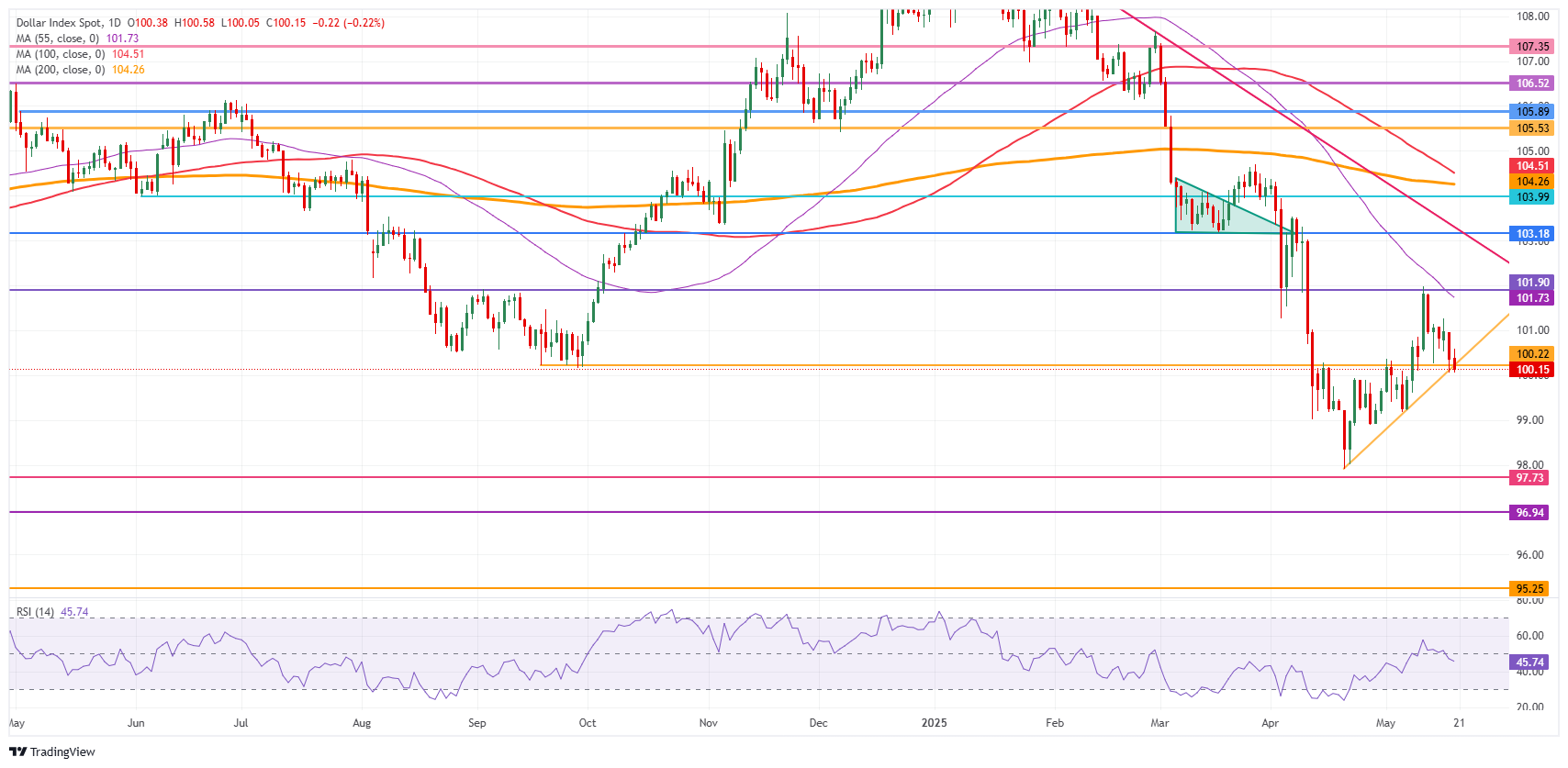-
The US Dollar Index extends its decline for a second straight day, testing the key 100.00 level as the impact of Moody’s US debt downgrade persists.
-
Investor confidence in the US takes another blow after President Trump signals a potential full withdrawal from Russia-Ukraine peace negotiations.
-
With ongoing pressure, the US Dollar Index risks breaking below 100.00, potentially revisiting its 2022 lows.
The US Dollar Index (DXY), which measures the Greenback’s performance against six major currencies, continues its decline for a second straight day on Tuesday as markets absorb the fallout from Moody’s recent downgrade of US sovereign debt, which sparked volatility in Treasury markets.
Adding to the pressure, geopolitical risks are intensifying. France, the United Kingdom, and Canada are reportedly weighing sanctions on Israel unless it halts its ground assault in Gaza and permits humanitarian aid into the region. Israeli Prime Minister Benjamin Netanyahu responded firmly, asserting Israel's right to self-defense.
Meanwhile, in the Russia-Ukraine conflict, EU leaders criticized US President Donald Trump’s abrupt withdrawal from mediation efforts following his two-hour call with Russian President Vladimir Putin. Trump, who had previously vowed to broker peace swiftly, stated that the US would step away from the talks entirely, declaring “it’s not our war to deal with,” according to Bloomberg. The reversal has raised concerns over the US’s global credibility, further undermining the US Dollar.
With few major economic releases on the calendar this week, traders are closely monitoring upcoming speeches from Federal Reserve (Fed) officials on Tuesday, following Monday’s generally hawkish tone.
Daily Digest Market Movers: Confidence in US Dollar Falters Further
The US Dollar continues to weaken as markets digest growing doubts over President Trump’s ability to lead on global issues. Following a two-hour phone call with Russian President Vladimir Putin, Trump announced that upcoming peace talks involving the EU, Russia, and Ukraine would proceed without US military or sanctions backing—a move interpreted by Bloomberg as an effort to accelerate diplomacy but one that is eroding confidence in US global leadership.
Meanwhile, a lineup of Federal Reserve officials is set to speak on Tuesday, filling a relatively quiet day for US economic data:
-
13:00 GMT – Richmond Fed President Thomas Barkin discusses rural economic growth in Virginia.
-
17:00 GMT – St. Louis Fed President Alberto Musalem speaks at the University of Minnesota.
-
21:00 GMT – Fed Governor Adriana Kugler delivers a commencement address at UC Berkeley.
-
23:00 GMT – Atlanta Fed President Raphael Bostic, San Francisco Fed President Mary Daly, and Cleveland Fed President Beth Hammack appear at the Atlanta Fed's Financial Markets Conference.
Market sentiment remains mixed. European equities edge higher after Germany’s DAX hits another record high, while US equity futures trend downward. The CME FedWatch Tool places odds of a rate cut at the Fed’s June meeting at just 8.6%, with a modest 33.1% probability for a cut by late July. Meanwhile, US 10-year Treasury yields cool to around 4.43% after Monday’s spike.
US Dollar Index Technical Analysis: Sentiment Continues to Sour
The US Dollar Index (DXY) is under renewed pressure as confidence in US leadership wanes. Following the credit rating downgrade by Moody’s, President Trump's indication that the US might withdraw from further involvement in the Russia-Ukraine peace process has raised further concerns about the reliability of US policy commitments. Traders are growing wary of the potential for unpredictable shifts or reversals under the Trump administration, adding weight to the bearish sentiment surrounding the Dollar.
On the upside, resistance at 101.90—a key level during December 2023 and part of the inverted head-and-shoulders pattern from mid-2024—remains the first major hurdle. The 55-day Simple Moving Average (SMA) at 101.94 reinforces this zone. A break above would open the door to retesting the 103.18 pivot.
To the downside, the ascending trendline near 100.22 is under pressure and could break if bearish momentum continues. A sustained drop may drive the DXY toward the 2024 low at 97.91 and the 97.73 pivot. If that fails to hold, technical support becomes scarce until 96.94, followed by deeper targets at 95.25 and 94.56—levels not seen since 2022.






